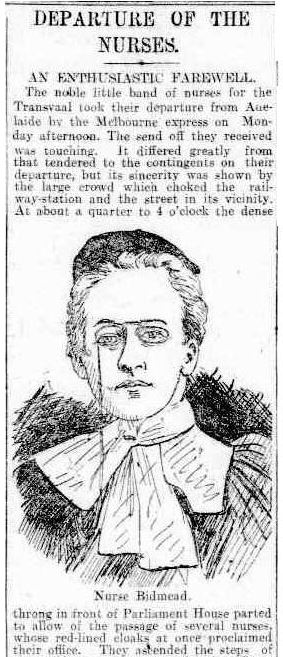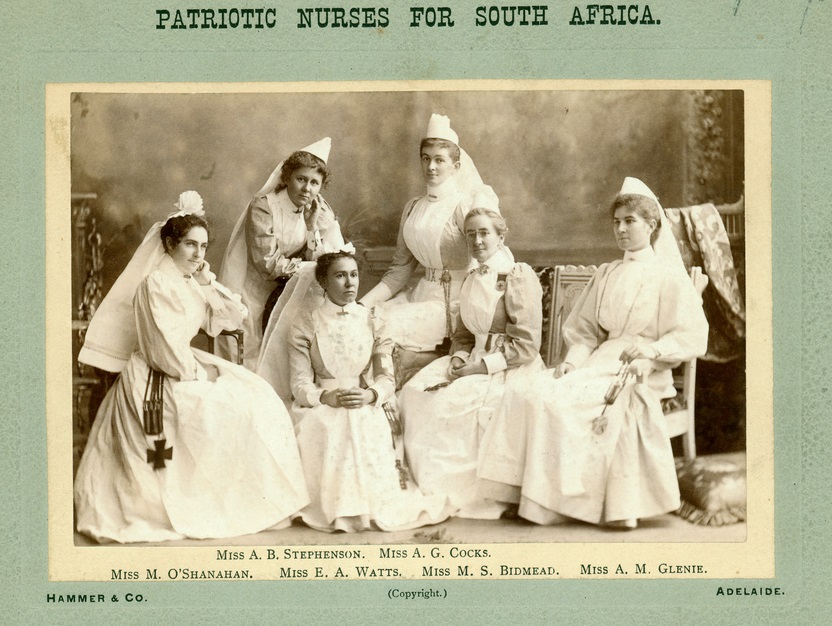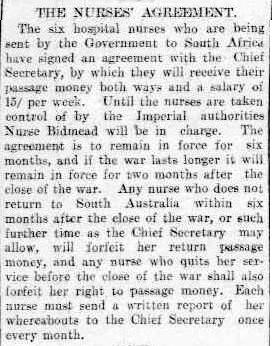Bidmead, Martha Sarah
Martha Sarah Bidmead was born on the 5th of December 1862 at St Peter Port, on Guernsey, in the Channel Islands. She was a Sister with the Australian and Colonial Military Forces and was deployed to South Africa in 1900 and placed in charge of the South Australian contingent of nurses.
Martha Bidmead was the daughter of Thomas Benjamin Bidmead (Tobacconist) and Anne Bidmead. After both of her parents died she migrated to South Australia with her four sisters, arriving on the 30th April 1885 aboard the ship John Elder. She began training at Adelaide Children's Hospital in July 1886 and was charge nurse there from 1887-89. For the next eight years she engaged in private nursing, then in 1898 was appointed staff nurse at Burra Burra District Hospital.
In 1899, when the South Australian government decided to send a detachment of nurses to the South African War, Sister Bidmead volunteered and was placed in charge of six nurses who left Australia on 21 February 1900. They were attached to the 2nd General Hospital at Winburg near Cape Town until June, and then transferred to the 10th General Hospital at Bloemfontein where the New South Wales Ambulance Corps was based. The nurses spent most of their time in tented medical wards tending cases of enteric fever (typhoid) and dysentery – diseases which accounted for a high proportion of casualties.
In March 1901 Sister Bidmead became ill and after a fortnight's leave was assigned to light duties at the 5th Stationary Hospital, Bloemfontein. She later took charge of the 10th General Hospital. Late in 1901 she went to England in charge of the wounded on a hospital ship SS ‘Dilwara’.
Short in stature, with a bustling nature, Martha Bidmead was a born leader with an arresting personality, a positive character and a deep rich voice. In retirement she found time for her favourite hobbies: playing bridge and tending the garden at Guernsey Cottage, the home she shared with her sisters at Arthur Street in Payneham. She died there of a chronic neurological disorder on 23 July 1940 and was cremated after a service at St Aidan's Anglican Church, Payneham.
Nursing and the Colonial Military Forces
At the commencement of the war in South Africa (1899) the British Army had just 88 full time nurses and despite some initial hesitation on deploying nurses, PCANSR (Princess Christian's Army Nursing Service Reserve) formed the basis of the employment of some 2000 nurses from all over the world during the war.
In the Australasian colonies there was a wide division of opinion as to nursing organization. This attitude was taken up by some commentators in the colonies. They were particularly scathing of any plan to deploy nurses. Nurses were not really necessary, one scribe going so far to claim that as civilian nurses had little or no experience of gunshot wounds they would be particularly useless and in the way in warfare. Others wanted to imply that women wanting to assist in this way were essentially going with immoral purpose in mind.
More than 60 Australian nurses went to the Boer war, either provided by governments or by privately raised funds or at their own expense. Four states NSW, Victoria, South Australia and Western Australia sent what could be described as official contingents, although they were very different in organisation.
Eventually there were 21 General Hospitals and 38 Stationary Hospitals in South Africa. Initially they experienced some resistance from the regular British Army Nursing Service and local nurses, but performed well in scattered groups or singly from Cape Town and Durban to Rhodesia and became highly regarded by their colleagues and superiors.
Establishing the South Australian Contingent

1900 'DEPARTURE OP THE NURSES.'
The Express and Telegraph (Adelaide, SA : 1867 - 1922),
20 February, p. 3. (ONE O'CLOCK EDITION),
viewed 05 Oct 2016,
http://nla.gov.au/nla.news-article208844543
In South Australia the government agreed to the creation of a South Australian Nursing Contingent under the supervision of Martha Bidmead however the entire organization and funding was paid for and controlled by a public committee. Nine nurses went from South Australia. Six of them, Martha Sarah Bidmead, Agnes G Cocks, Eliza Ann Watts, M A O’Shanahan, Agnes Maud Glenie and Amelia Bramleyn Stephenson were recruited and funded by the South Australian Fund for War Nurses (part of the Patriotic Fund movement), the patron of which was Lady Tennyson the wife of the governor. The army itself had nothing to do with the group which was regarded as civil and they travelled overland to embark as commercial passengers in Melbourne. They departed Adelaide on the 19th of February 1900 by train for Melbourne and left Melbourne on the S.S. Australasian on the 21st of February 1900 with the fourth detachment of N.S.W. Lancers.

State Library of South Australia
Studio Photograph Of South Australian Nurses
Titled 'Patriotic Nurses For South Africa'. 1899.
http://collections.slsa.sa.gov.au/resource/B+9065
Whilst in Africa all of the South Australian nurses came under the command of the British War Office and then ‘The Nurses Agreement” came into effect. Details of ‘The Nurses Agreement’ were reported in The Telegraph on Tue 20th Feb 1900.1

Correspondence
In an interview in The Express and Telegraph on Wednesday the 18th of June 1902 Sister Bidmead wrote:
"We were soon sent on to Bloemfontein while we were attached to the No 10 General Hospital, the headquarters being Grey’s College in that town. All public buildings in the place were reserved for hospitals. When we arrived the New South Wales Hospital Field Brigade were just vacating the Artillery Barracks from the front. The South Australian nurses were placed in sole charge of the place and there we remained together for about five months. Enteric fever (typhoid) was raging badly during that period and we were kept busily engaged for a long time; too busy in fact to be able to make enquiries about the progress of the war. There were a number of wounded Boer prisoners, including Commandant Banks in our hospital. They were of a rather sullen disposition. I always refrained from entering into any conversation referring to the disputes that led up to the war and everything passed off amicably at the hospital. Two Irish Americans, who had fought on the side of the Boers, were rather frank in their expression, but very good-natured and nothing said was taken amiss.
In a house near our hospital 11 Boers were arrested while in the act of cleaning their rifles. During the time we were at the Artillery Barracks we had 500 cases under our charge and out of these only 27 deaths occurred. Nearly all the deaths resulted from enteric fever and very few from wounds. I can tell you we felt proud of our splendid record. We gained a wonderful experience. At first were short of some necessary articles for our work, but that was not to be wondered at considering the crowded state of the hospitals in such a short time and that there was only one railway for forwarding everything required from Cape Town. In fact, it is surprising how such splendid arrangements could have been made in so short a period of time. I had only a small knife for spreading the poultices, and as every minute was precious to me I used a bayonet for the work. It acted so efficiently that I continued the use it afterwards.At the end of the five months we six South
Australian nurses were separated. One was sent to Pretoria, another to Harrismith and a third to Modder River. I went to the headquarters of the No. 10 General Hospital at Grey’s College and remained there till the end of last year when I proceeded to London. It made my blood boil to hear some of the false charges against the British for their treatment of the Boers in the concentration camps.
I was asked when in London if I would go back to South Africa again, but declined as I knew that my services were not so much needed as at the beginning of the war. Nurses O'Shanahan, Cocks and Watts are still in South Africa. Nurse Stephenson returned to South Australia at the end of last year and Nurse Glenie just recently" 2
In another letter printed in the Adelaide Observer on Sat 19th Jan 1901 she wrote:
“Our building keeps very full, Grey’s being headquarters. A bed is no sooner emptied than it is reoccupied. No. 8 received 60 wounded soldiers from Dewetsdorp the other day. We had not nearly enough beds for them. There is no word yet of our leaving Africa. They have enteric at Pretoria, and we are told we may expect its reappearance here when the rains set in. There are only about 7000 to 8000 troops at present here, so the sickness cannot be nearly as severe as it was during last April, May and June. There is great difficulty in procuring anything like a sufficient quantity of fresh milk and vegetables. The land is as bare as if a swarm of locusts had passed over it. The farmers are in exile or on commando. Everything is shockingly dear.” 3
At the time this letter was sent Bloemfontein was under severe pressure and the city was locked down with wire fences barring most of the streets. Security passes were required to travel anywhere in the city.
Commendations
Martha Bidmead received several medals for her service during the Boer war. She was awarded the Royal Red Cross on the 10th of December 1901, becoming the first South Australian to ever receive this honour. She was awarded her medal from Edward VII along with her colleagues, Elizabeth Nixon from New South Wales and Sister Rawson from Victoria. The ceremony was held at St James’ Palace in London on the 12th March 1902.
She was awarded the Queen’s and King’s South African Service medals and in June 1902 she was presented with the Devoted Service Cross by the Nurses Fund Committee. This decoration was described as being in gold and being in the form of a Laurel Wreath overlayed by the crossed flags of the Union Jack and South Australia the whole suspended by two chains from a plain bar with the inscription '1901 Africa' 1902. On return the nurses sent by the South Australian Fund for War Nurses were all presented with the Devoted Service Cross. On the reverse of the decoration was the inscription:”
Presented to Nursing Sister XXXX
On behalf of the subscribers to the
South Australia Fund for War Nurses 4
References
- Express and Telegraph (Adelaide, SA : 1867 - 1922), Tuesday 20 February 1900, page 2
- 1902 'NURSE BIDMEAD.', The Express and Telegraph (Adelaide, SA : 1867 - 1922), 18 June, p. 3. (1 o'clock.), viewed 05 Oct 2016, http://nla.gov.au/nla.news-article208733847
- 1901 'OUR NURSES IN AFRICA.', Adelaide Observer (SA : 1843 - 1904), 19 January, p. 41. , viewed 05 Oct 2016, http://nla.gov.au/nla.news-article162404363
- Max, Chamberlain. "Nurses In The Boer War". Boar War Memorial, 2016. http://bwm.org.au/nurses.php Web. 5 Oct. 2016.
Online Resources
Bassett, Jan, Guns and brooches : Australian Army Nursing from the Boer War to the Gulf War, Oxford University Press, Melbourne, 1992, 261 pp;
Clark, Rex. 'Bidmead, Martha Sarah (1862–1940)', Australian Dictionary of Biography, National Centre of Biography, Australian National University, http://adb.anu.edu.au/biography/bidmead-martha-sarah-5232/text8807, published first in hardcopy 1979, accessed online 5 October 2016.
Desey, David. "Matron Martha Bidmead". Boar War Memorial. N.p., 2016. http://bwm.org.au/site/Martha_Bidmead.php Web. 5 Oct. 2016. (no longer available)
Francis, Rosemary. "Bidmead, Martha Sarah (1962 - 1940)". The Australian Women's Register. N.p., 2009. Web. 5 Oct. 2016, http://www.womenaustralia.info/biogs/IMP0069b.htm
Max, Chamberlain. "Nurses In The Boer War". Boar War Memorial, 2016. http://bwm.org.au/nurses.php Web. 5 Oct. 2016.
.
